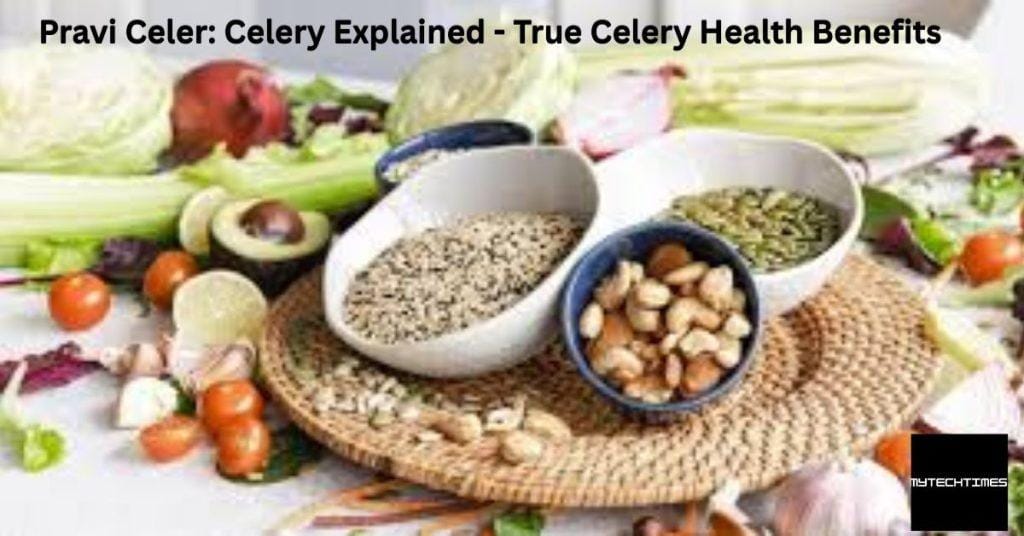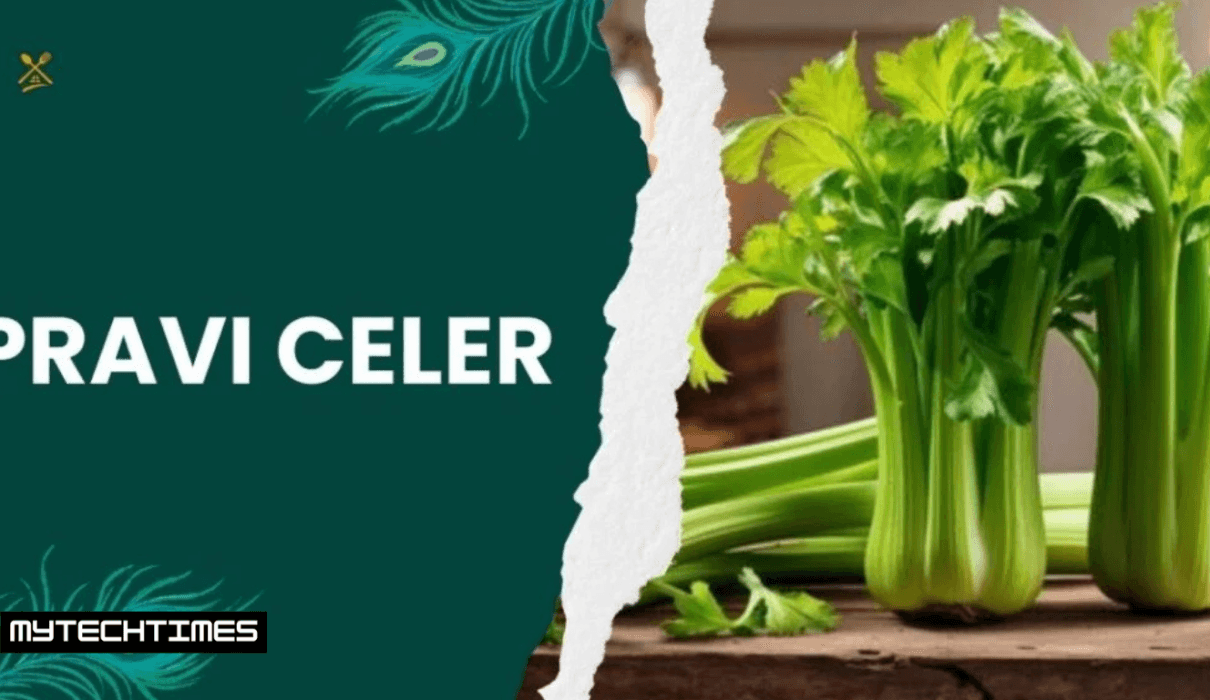Pravi Celer: Celery Explained – True Celery Health Benefits
Pravi Celer, often called real celery, is more than just a crunchy vegetable in your kitchen. Both the celery stalks and the celery root carry natural benefits that many people overlook. Unlike heavily processed foods, Pravi Celer is authentic, fresh, and directly linked to better health and nutrition. Here are seven secrets that make this humble plant a real powerhouse.
1. A Natural Detox Powerhouse
- Celery stalks are rich in water and antioxidants.
- Helps the body flush out toxins naturally.
- Supports liver health and keeps the digestive system clean.
- Works as a hydrating vegetable for daily detox routines.
2. Anti-Inflammatory Benefits for Long-Term Wellness
- Contains apigenin and luteolin, compounds known to reduce inflammation.
- Regular intake may help with arthritis, joint pain, and chronic swelling.
- Unlike processed supplements, real celery offers these benefits naturally.
3. Nutrient-Rich but Low in Calories
- Packed with Vitamin K, Vitamin C, Vitamin A, folate, and potassium.
- Aids in blood clotting, bone health, and energy production.
- Low-calorie yet nutrient-dense, making it perfect for weight management.
4. Supports Digestive Harmony
- High in natural dietary fiber, both soluble and insoluble.
- Promotes smooth digestion and prevents constipation.
- Acts as a natural prebiotic, feeding healthy gut bacteria.
5. Boosts Hydration and Skin Health
- Made up of nearly 95% water, keeping you hydrated.
- Regular use can help maintain glowing skin and prevent dryness.
- Works well in juices, smoothies, or raw snacks for daily hydration.
6. Versatile in the Kitchen
- Can be eaten raw in salads, smoothies, or crunchy snacks.
- Adds depth to soups, stews, and roasted dishes.
- Celery root is often used in European cuisines as a seasoning or mash.
7. A Natural Ally for Heart and Immune Health
- Potassium helps regulate blood pressure naturally.
- Antioxidants strengthen the immune system.
- May reduce cholesterol and support long-term heart health.
Quick Reference Table: Pravi Celer Secrets at a Glance
| Secret | Key Benefit | Best Way to Use |
| Detox | Flushes toxins | Juices, smoothies |
| Anti-Inflammatory | Reduces swelling | Raw or cooked |
| Nutrient-Rich | Vitamins & minerals | Salads, soups |
| Digestive Support | Fiber for gut health | Fresh stalks |
| Hydration | Water-rich | Juices, raw snacks |
| Culinary Use | Versatile flavor | Soups, stews, salads |
| Heart & Immunity | Blood pressure & defense | Daily intake |
Pros of Pravi Celer
Natural Detox Support
Rich in antioxidants and water content that help flush toxins from the body.
Hydration Boost
With nearly 95% water, celery stalks are an excellent hydration vegetable.
Nutrient-Rich but Low-Calorie
Provides Vitamin K, Vitamin C, folate, and potassium without adding extra calories.
Supports Digestive Health
High in dietary fiber, which improves digestion and prevents constipation.
Anti-Inflammatory Properties
Contains compounds like apigenin and luteolin that naturally reduce swelling and joint pain.
Versatile in Meals
Can be eaten raw, juiced, cooked, or used as seasoning (especially celery root).
Heart and Immune Support
Potassium regulates blood pressure, while antioxidants strengthen the immune system.
Cons of Pravi Celer
High Sodium Content (Natural)
While not harmful for most people, those on a low-salt diet should watch intake.
Possible Allergic Reactions
Some individuals may be allergic to celery, leading to itching, swelling, or digestive discomfort.
Digestive Issues in Excess
Overeating raw celery may cause bloating or gas due to its high fiber.
Not a Complete Food
Celery is nutrient-rich but cannot replace a balanced diet. It works best when paired with other foods.
Short Shelf Life
Fresh celery stalks lose crunch and nutrients quickly if not stored properly.
Pesticide Concerns
Conventionally grown celery often ranks high in pesticide residues. Organic versions are better.
Quick Comparison Table
| Aspect | Pros | Cons |
| Detox | Flushes toxins naturally | Can’t replace medical detox |
| Hydration | 95% water for hydration | Doesn’t replace plain water |
| Nutrition | Rich in vitamins & minerals | Not a full meal source |
| Digestion | Fiber supports gut health | Excess may cause gas |
| Cooking Use | Versatile in dishes | Short shelf life |
| Safety | Natural & authentic | Allergy risk, pesticides |
1. Scientific and Historical Background of Celery

Celery has been part of human diets for thousands of years. Ancient Egyptians used celery seeds for medicine, while Greeks and Romans considered celery a healing food. Modern science now confirms many of these beliefs. Celery contains apigenin, luteolin, and phthalides, compounds known for their antioxidant and anti-inflammatory effects. Research also shows celery supports blood pressure regulation and liver health.
2. Celery Stalk vs. Celery Root (Celeriac): What’s the Difference?
Both parts of pravi celer are edible, but they offer different nutrients.
| Nutrient (per 100g) | Celery Stalk | Celery Root (Celeriac) |
| Calories | 14 kcal | 42 kcal |
| Fiber | 1.6 g | 1.8 g |
| Vitamin K | Very High | Moderate |
| Vitamin C | Moderate | High |
| Potassium | Good source | Higher amount |
| Carbs | Very Low | Higher (energy-rich) |
👉 The stalks are light, crisp, and hydrating, while the root (celeriac) is denser, earthy, and energy-rich. Both bring unique value to a healthy diet.
3. Safety, Side Effects, and Recommended Intake
Celery is safe for most people, but there are a few things to note:
- Blood Thinners: High vitamin K in celery may interfere with blood-thinning medicines.
- Pregnancy & Kidney Issues: Celery is a natural diuretic, so too much can cause excess urination or strain kidneys.
- Allergies: Rare, but some people may react to celery proteins.
- Safe Intake: 1–2 stalks a day, or half a medium root, is usually safe and beneficial. Celery juice (1 small glass) can be enjoyed, but balance it with whole celery for fiber.
4. Celery in World Cuisines and Traditional Medicine
Celery is not just a salad vegetable—it has global value:
- Chinese Cuisine: Stir-fried celery with meat and tofu.
- Indian & Ayurvedic Use: Celery seeds are used to reduce inflammation and support digestion.
- Mediterranean Diet: Celery root in soups, roasted dishes, and seasoning bases.
- Traditional Chinese Medicine (TCM): Celery is considered a “cooling” food that helps lower blood pressure.
5. The Celery Juice Trend: Facts vs. Myths
Celery juice became a viral wellness trend, but not all claims are true.
- True: Celery juice hydrates, provides antioxidants, and may support digestion.
- Myth: Celery juice alone cures chronic diseases or completely detoxes your body.
The real health power comes when celery is part of a balanced diet, not a miracle drink.
6. Storage and Preservation Beyond Fresh Use
If you want celery to last longer, here are practical tips:
- Fresh Storage: Wrap in foil or a damp cloth in the fridge to keep stalks crisp for 1–2 weeks.
- Freezing: Chop celery stalks and blanch before freezing. Celery root can also be diced and frozen for soups.
- Drying Leaves: Dry or dehydrate celery leaves to use as a seasoning powder.
- Juice Shelf Life: Fresh celery juice should be consumed within 24 hours for best nutrients.
7. Easy Recipes and Daily Uses of Celery
Pravi celer can be added to your diet in many creative ways:
- Celery Root Mash: A healthy alternative to mashed potatoes.
- Green Detox Juice: Blend celery, cucumber, and apple for a refreshing drink.
- Celery Pesto: Use celery leaves with olive oil, garlic, and nuts.
- Classic Mirepoix: Celery, onion, and carrot as a base for soups and stews.
8. Organic Celery and Sustainability
Celery is known to have higher pesticide residues compared to many vegetables. That’s why many health experts recommend buying organic celery when possible.
- Organic Celery: Grown without harmful chemicals, safer for regular juicing and raw use.
- Eco Footprint: Celery is not a heavy water user compared to crops like rice, but organic farming makes it more eco-friendly.
What Is Pravi Celer? A Natural Guide to Real Celery
Definition and Origins of Pravi Celer (Stalk vs. Root)
Pravi celer literally means “true celery,” referring to the authentic, unhybridized form of Apium graveolens. Unlike industrial varieties bred for uniform stalks, pravi celer emphasizes the whole celery plant—including stalks, leaves, and root—that captures the full flavor and tradition.
Cultivated across the Mediterranean and Europe for centuries, it’s the version filled with cultural significance and traditional uses that many modern sources overlook. In some places, “pravi celer” refers specifically to crunchy stalk celery, while elsewhere it includes root celery (celeriac) and leaves—each contributing distinct textures and health benefits.
What Makes It “Natural”: Authentic, Not Processed
In contrast with processed or hybrid celery, pravi celer is celebrated for being true to its roots—untouched, full-spectrum, and naturally rich in anti-inflammatory properties. Because it preserves authentic nutrition, it promotes digestive health and helps lower blood pressure.
Moreover, it’s traditionally grown, often without synthetic inputs, and valued for its resourcefulness. Nothing is wasted: leaves serve as seasoning, roots go into stews, and stalks add crunch. This whole-plant approach connects celery with heritage farming and sustainability, adding depth that many modern sites miss.
Health Benefits of Celery: Why Pravi Celer Deserves a Spot in Your Healthy Diet
Detoxification, Hydration & Digestive Harmony
Since pravi celer is about 95% water, it acts as both a hydrator and a natural diuretic. As a result, it supports detoxification by helping flush excess salt and toxins. In addition, the fiber content combines digestion, reduces inflammation and supports the regularity of the intestine – an advantage recognized in folks for centuries.
Heart Health, Inflammation Reduction & Immune Support
Pravi celer is rich in potassium and antioxidants, which makes it excellent for heart health. It helps regulate blood pressure and supports circulation. Furthermore, compounds such as apigenin and luteolin reduce inflammation while strengthening immune defenses.
Nutrition Explained: Vitamins, Minerals, and Fiber-Rich Power of Celery Stalks & Root
Key Vitamins and Minerals: Vitamin K, C, A, Potassium, Folate
Pravi Celer offers an impressive nutritional package: vitamin K and blood clot for bone, vitamin C for immunity, vitamin A for vision, potassium for fluid balance and energy folate for energy and cell repair.
Fiber-Rich, Nutrient-Dense, Low-Calorie Highlight
Because it’s both high in fiber and low in calories (around 16 kcal per 100 g), pravi celer offers nutrient density without bulk. In short, it helps you feel full while still nourishing your body.
Why “Low-Calorie” Doesn’t Mean Less Valuable: Celery as a Healthy Diet Hero
Weight Management and Satiety
Low in calories yet high in fiber, fresh celery supports healthy weight goals. Thanks to its crunch and hydration, it works as a satisfying snack that helps control hunger.
The Myth of “Negative-Calorie” Foods
Celery is sometimes labeled as a “negative-calorie” food, meaning digestion supposedly burns more calories than it provides. However, this claim isn’t scientifically proven. Even so, its fiber and water content still aid in appetite management.
From Crisp Texture to Cooking Ingredient: Culinary Uses of Pravi Celer
Raw Crunch: Salads, Snacks, Juices
Pravi celer’s crisp stalks shine in salads, crudité platters, and juices. Additionally, its leaves make a flavorful seasoning that adds freshness and a peppery bite.
Cooking Versatility: Soups, Stews, Roasts, Seasoning
When cooked, pravi celer becomes a kitchen staple. It enriches soups, stews, and sauces, while celeriac root can be roasted, mashed, or stewed in hearty dishes. Even the leaves provide depth in sauces and broths.
Growing, Buying, and Storing Pravi Celer—Your Complete Guide
How to Choose Fresh Pravi Celer
Look for firm stalks with vibrant leaves. Avoid limp or yellowing parts. For root celery, pick medium-sized knobby roots with no cracks.
Storing Tips to Preserve Crisp Texture
Wrap the stalk in plastic or keep them straight in water for maximum crunch. Roots store the best in the refrigerator vegetable drawer. Always wash before using to expand the freshness.
Quick Growing Tips (If You Want to Grow at Home)
Start seeds indoors, transplant them into rich soil, and keep the plants well-watered. Harvest stalks or roots once they reach full maturity.
Comparison Table
| Feature | Pravi Celer (Whole, Natural) | Common Processed Celery or Juices |
| Plant Parts Used | Stalks, Leaves, Root | Mostly stalks only |
| Processing | None; unhybridized, traditional | Often mass-produced or juiced |
| Nutritional Richness | Full vitamins, fiber, essential oils | Nutrients may be diminished |
| Culinary & Cultural Value | Deep tradition, versatile in cooking | Mostly modern, limited use |
| Environmental Impact | Often sustainable, low-input | Higher water and farming inputs |
Final Thoughts
Think of pravi celer as the whole celery plant—reuniting tradition, nutrition, and vibrant flavor. It isn’t just another stalk on the shelf. Instead, it’s an authentic food that honors heritage, health, and honest cooking.
FAQs on Pravi Celer
Q: Is Pravi Celer different from regular celery?
Yes, the term “Pravi Celer” refers to authentic, real celery (both stalk and root), often emphasized for its natural and unprocessed benefits.
Q: Can I use celery root like stalks?
Yes, but celery root (celeriac) has a stronger flavor and is mostly used in soups, stews, or mashed as a side dish.
Q: How often should I eat celery for benefits?
Including celery 3–4 times a week in raw or cooked form is enough to enjoy its detox and nutritional effects.
Q: Does celery really help with weight loss?
Yes, due to its low-calorie and high-fiber profile, it helps with satiety and weight management.
Q: Can celery juice replace water for hydration?
Not fully, but celery juice adds hydration plus minerals, making it a healthier option compared to plain water alone.
Q: What makes pravi celer different from supermarket celery?
It emphasizes the whole plant—roots, stalks, and leaves—grown traditionally without heavy hybridization.
Q: Can I eat the root and leaves too?
Absolutely. The root (celeriac) is hearty and great in stews, while leaves add seasoning and stalks provide hydration and crunch.
Q: Why praise its “natural” qualities?
Because pravi celer retains its authentic nutritional profile and versatility—without processing or genetic tinkering.
Q: Is celery juice better than eating it whole?
Juice is excellent for hydration, but eating the whole plant adds fiber and satiety. Both have their place in a balanced diet.
Q: Are any people at risk from celery?
Most can enjoy it safely. However, people with celery allergies, those on blood thinners, or pregnant individuals should consult a healthcare provider first.
This page contains useful information and several related articles. You can read them to gain more insights on the topic.



